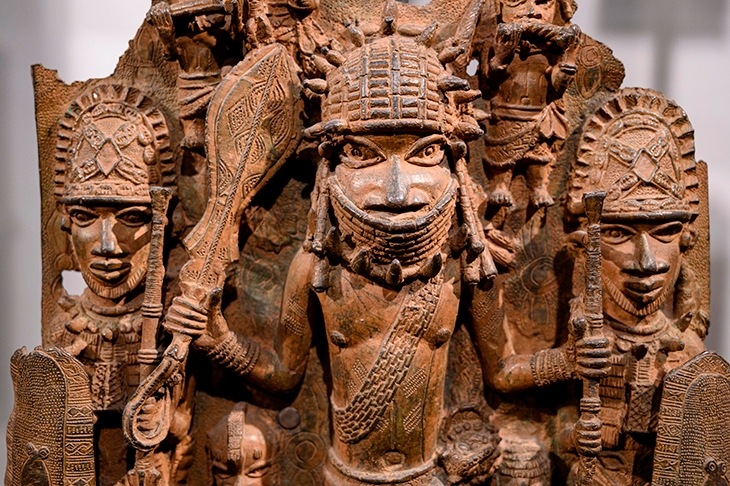A book about the looted African art known as the Benin Bronzes begins by clarifying that most of them are not actually bronze, and none of them comes from the country of Benin. Yet as this gripping work of live history makes clear, such name ambiguity feels entirely appropriate for art so sophisticated in creation yet so controversial in acquisition. Little about the Benin Bronzes is black and white.
The exact age is unknown for the cache of carved ivory, coral and metal plaques, heads, statuary, swords and other ceremonial objects, the best guess emphasizing the circa in ‘circa 16th century’. Who the heads represent is also not settled — most likely monarchs from the now faded kingdom of Benin, a tessera in the ethnic mosaic of modern-day Nigeria, but possibly gods, or vanquished enemies. Even the size of the hoard is unknown, some estimates saying 2,000, others double that.
What is unarguable is their artistic merit. When western experts first saw them at the turn of the 20th century, comparisons were made with the works of Benvenuto Cellini and the finest sculptors of ancient Greece. The Benin Bronzes alone recalibrated how the art world regarded a continent. But it is how those westerners got to see the Benin Bronzes that supercharges them to this day, placing the cache at the heart of current controversies over race, treasure and history. With only a very few exceptions, they were all nicked by British colonial forces in 1897.
We are not referring here to a few junior ranks surreptitiously squirreling the stuff away like the Royal Marines in 2003 who pinched gold-plated plumbing from Saddam Hussein’s palace in Basra. When British forces conquered Benin City, they were all involved, right up to the admiral in overall command, eager to cash in on what one officer called ‘a regular harvest of loot’.
The account of how Britain scrambled to take an interest in the territory in the late 19th century; the maneuverings of colonial carpetbaggers inveigling its king, or Oba, into supposedly signing away rights; the insensitivity of a headstrong British colonialist who was killed by warriors and the subsequent punitive attack on the capital by a British force is all well handled by Barnaby Phillips. The storytelling is crisp, balanced and authoritative, as you might expect from a highly experienced foreign correspondent who has covered much of Africa for the BBC.
The three-pronged attack by a well-armed force that eventually led to the enemy’s capital being burned to the ground comes straight out of the British colonial playbook. The same template had been deployed two decades earlier against the Zulus further south. And the looting of the treasures was so routine that those who took part made no effort in diaries, letters and books to conceal it. By the 1890s, laws existed to stop plunder by modern armies, but, as Phillips reveals tellingly, they did not apply to ‘uncivilized’ enemies. In the racist hierarchy of 1897, African tribes merited no protection.
It is the handling of this seeping undertone of racism that makes this book so valuable, a primer for the debate on colonial guilt and echoing white supremacy. Phillips records the art establishment’s dogged refusal to accept the Benin Bronzes were even African. Racial hierarchy meant surely they had been brought to Africa from elsewhere, Portugal, perhaps, or India.
But slowly the consensus shifted, and the Benin Bronzes have taken their place as symbols of high African art, single pieces changing hands at auction today for millions of pounds. Sometimes the seeping is subconscious, the British Museum displaying its holding not in well-lit galleries alongside Roman works but in the basement alongside tribal curiosities.
It is this incremental change of attitudes that stands out in this telling book. In contrast to the initial punitive attack which took just days to orchestrate, or the on-selling of some pieces which left an African city where they had been located for centuries only to be shifted between London, Berlin and Vienna within months, the issue of the Benin Bronzes has been a slow burn. Whenever the subject of their provenance has come up with requests for their return to Nigeria, it has always been parried. But Phillips captures the voices, many from Nigeria, who argue that to send them back would lead to them being stolen (again) and sold for profit.
As Britain continues to twist on the thorny issue of racism, from Buckingham Palace to the terraces of soccer grounds, this book’s laser-sharp focus on the casenotes from one instance of colonial cruelty allows for a much more informed understanding of the wider issue. Whereas before the now highly valuable Benin Bronzes might have had us looking in the attic for some forgotten heirloom, perhaps now we are left examining our consciences.
This article was originally published in The Spectator’s UK magazine. Subscribe to the World edition here.


















